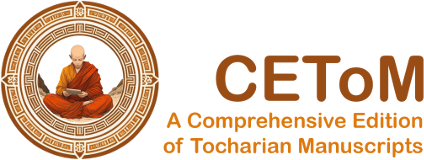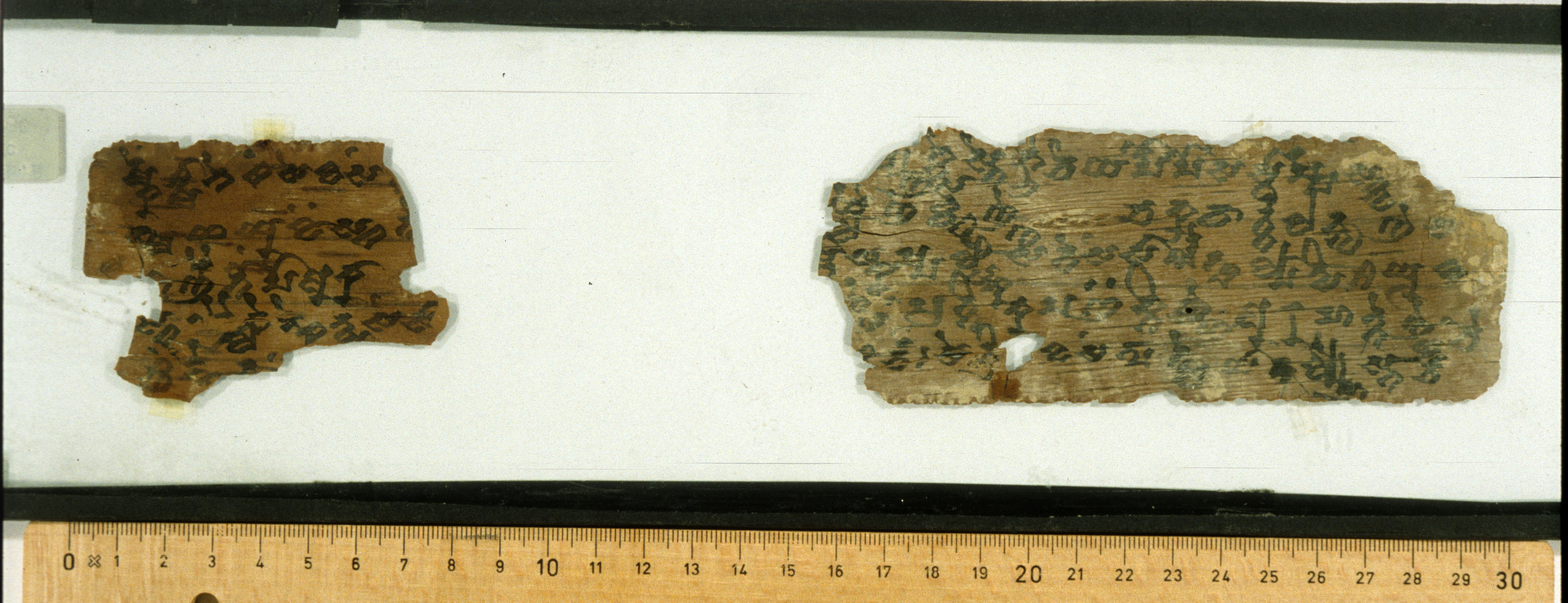THT 1121
| Known as: | THT 1121; KVāc 30 |
|---|---|
| Cite this page as: | Hannes A. Fellner; Theresa Illés (collaborator). "THT 1121". In A Comprehensive Edition of Tocharian Manuscripts (CEToM). Created and maintained by Melanie Malzahn, Martin Braun, Hannes A. Fellner, and Bernhard Koller. https://cetom.univie.ac.at/?m-tht1121 (accessed 12 Jul. 2025). |
Edition | |
| Editor: | Hannes A. Fellner; Theresa Illés (collaborator) |
Provenience | |
| Main find spot: | Unknown |
| Collection: | Berlin Turfan Collection |
Language and Script | |
| Language: | TB |
| Linguistic stage: | classical |
| Script: | classical |
Text contents | |
| Title of the work: | Karmavācanā |
| Text genre: | Literary |
| Text subgenre: | Vinaya |
| Verse/Prose: | prose |
Object | |
| Manuscript: | THT 1102-1125 |
| Preceding fragment: | THT 1120 |
| Following fragment: | THT 1122 |
| Material: | ink on wood tablet |
| Form: | Poṭhī |
| Size (h × w): | 5.6 × 29 cm |
| Number of lines: | 5 |
Images
Images from idp.bl.uk by courtesy of the International Dunhuang Project, the Berlin-Brandenburgische Akademie der Wissenschaften, and the Staatsbibliothek zu Berlin – Orientabteilung.
Transliteration
(continues from THT 1120)
| a1 | nt· t· i [ka] /// /// s· o no lmeṃ tsa na wä nta rwa meṃ ka llā lle • ce |
|---|---|
| a2 | yä kne sa snai o n· lm· t[s]· – /// /// te ke na meṃ ke na ṣṣa na pa ra ma nu nta meṃ sa· vā rka |
| a3 | ·[l]ā lle • po mo ta rcca – /// /// [l]y· nta m[e]ṃ • kuse śa ktā lye nta ske nte e tsu wai e lau ke |
| a4 | wa¯ ¯t po meṃ sa nva rka [ll]· – /// /// [l]m· tsa na wa nta rwa meṃ ka llā lle • ma kte te o |
| a5 | no lmeṃ tsa na snai o [no] lm· – – /// /// – [sa]ṃ tai sa c·i wa saṃ tpā ta pi ya rpo ntse ya |
| b1 | rmke śmā ne saṃ se wa saṃ /// /// lyñ· kuse ste krui ce ya rpo saṃ sā rṣṣa skwa |
| b2 | nma¯ ¯ś yu wä¯ ¯st t[e] /// /// ylai ñä kta ññe ca hhra vā rtti la ntu ñe sa |
| b3 | [wa] rñai toṃ po a kā· – – /// /// – m[rau] ska ṣpa lsko sa te saṃ sā rmeṃ tsa lpā tsi¯ ¯ś yū wa |
| b4 | ¯st • [t]rai kle ṅke ntsa saṃ sā· – /// /// ññe • pra tti ka pa ñä kti ññe a ra ha nte ññe • ce |
| b5 | ścä ṅke [n]·[a¯] [¯]·[ä] /// /// [ta]¯ ¯rcä : se tri – wa saṃ tpā n[ts]e yā ta lyñe sta¯ ¯rc |
(continues on THT 1122)
Transcription
(continues from THT 1120)
| a1 | n1n2 nt· t· ikä(ṃ) /// /// (yäkne)s(a) onolmeṃtsana wäntarwameṃ källālle • ce |
|---|---|
| a2 | n3n4n5 yäknesa snai on(o)lm(eṃ)ts(ana) /// /// te kenameṃ kenaṣṣana paramanuntameṃ sa(ṃ)vār kä¬ |
| a3 | (l)lāllen6n7n8 • po motarcca(na) /// /// (śäktā)ly(e)ntameṃ • kuse śäktālyenta skente etsuwai elauke |
| a4 | n8n9n10n11 wat pomeṃ sanvar käll(ālle) /// /// (snai) (ono)lm(eṃ)tsana wantarwameṃ källālle • mäkte te o¬ |
| a5 | nolmeṃtsanan12n13n14 snai onolm(eṃtsana) /// /// (ne)säṃ taisa c(w)i wasaṃtpātä{ṣṣe}pi yarpontse ya¬ |
| b1 | rmn15n16n17 keś mā nesäṃ se wasaṃ(tpātäṣṣe) /// /// (pke)lyñ(e) kuse ste krui ce yarpo saṃsārṣṣa skwa¬ |
| b2 | nmaśn18n19 yuwäst te /// /// ylai-ñäktäññe cahhravārtti lantuñesa |
| b3 | n20 warñai toṃ po akā(lkänta) /// /// (ma)mrauskaṣ palskosa te saṃsārmeṃ tsälpātsiś yūwa¬ |
| b4 | stn21n22 • trai kleṅkentsa saṃsā(rmeṃ) (tsälpātär) /// /// (pañäkti)ññe • prattika-pañäktiññe arahanteññe • ce¬ |
| b5 | śn23n24n25n26 cäṅken·a· /// /// (kne)tär-c : se tri(te) wasaṃtpāntse yātalyñe star-c |
(continues on THT 1122)
Translation
(continues from THT 1120)
| a1 | ... twenty(?) .... In (this way) it [=merit] can be obtained from the organic elements. In which |
|---|---|
| a2 | way (can it be obtained from) the inorganic (elements)? In this way, from [the element] earth [and] from the atoms of the earth, self-discipline may be |
| a3 | obtained: From all green, (white(?) [and] black(?)) seeds, whatever seeds there are near or far, |
| a4 | from all [of them] self-discipline can be obtained. (Thus) it can be obtained from (all organic [and] inor)ganic elements. Just as |
| a5 | the organic [and] inorganic (elements have neither measure nor number), just so the merit of ordination has |
| b1 | neither measure nor number. This (for you is the second effect) of ordin(ation). [3.] (Fruition [= requital of deeds]), what is [this]? When you let come to fruition this merit for all goods of happiness in the saṃsāra, |
| b2 | (you will obtain(?) all) this. All [your] desires [such as] the dignity of Indra, the dignity of a cakravartin king, |
| b3 | and so on(will be fulfilled for you. But if) you let this [=merit] come to fruition with a mind filled with [life-]weariness for release from the saṃsāra, |
| b4 | [then] (you will be released from the) saṃsāra by [one of] three paths: ([the path] of the) Buddha, of the Pratyekabuddha [and] of the Arhat. |
| b5 | To whatever .... (you will turn to, release from the saṃsāra will be) yours. This for you is the thi(rd) effect of ordination. |
(continues on THT 1122)
Commentary
Philological commentary
| The supplementation and commentaries follow Schmidt 1986: 30, 142. | |
| n2 | The gap contains about 14 akṣaras. |
| n5 | The gap contains about 7 akṣaras. |
| n7 | The gap contains about 8 akṣaras. |
| n11 | The gap contains about 9 akṣaras. |
| n14 | The gap contains about 7 akṣaras. |
| n17 | The gap contains about 11 akṣaras. |
| n19 | The gap contains about 8 akṣaras. |
| n20 | The gap contains about 5 akṣaras. |
| n22 | The gap contains about 7 akṣaras. |
| n26 | The gap contains about 12 akṣaras. |
Remarks
| According to Schmidt 1986: iv-v this ms. comes either from Qizil or from Tumšuq. | |
| From this leaf 2 fragments are preserved: one from the left side of the leaf to the string hole, consisting of 2 pieces and about 7 cm wide, and the right half of of the leaf, about 14 cm wide. | |
| The original ms. was 29 cm wide and 5.6 cm high, with the string hole 6.5 cm from the left margin. It was written by at least three hands: scribe 1, a beautiful, delicate script, from leaf 1 to 11 a1; scribe 2, distinguished by a number of orthographical idiosyncrasies/errors, from leaf 11 a1 to and including 19; scribe 3 from leaf 20 to end. The final leaves A and B THT 1123 and THT 1124 may have been written either by scribe 2 or a fourth hand. Cf. Schmidt 1986: v, 2, 6 | |
| This leaf is in hand 3. |
Linguistic commentary
| n1 | Instead of ikä, which would have to be supplemented to ikäṃ, one could also read itä or isä. |
|---|---|
| n3 | paramanuntameṃ for paramānuntameṃ; saṃvār for saṃvar. |
| n4 | onolmeṃtsana: for a possible further supplementation cf. line a 1. |
| n6 | With the help of (mo)tärcce (IOL Toch 106 b5), = Skt. harita, the meaning of motarcca(na), Pl. Fem. of an adjective, can be identified as ‘green’ (for more detail see Schmidt 1984: 152). In TA there is motarci (Nom.Sg.Fem.), which, according to TEB II: 127, denotes a colour that is probably dark, but otherwise unidentifiable. Etymologically, this colour adjective must be connected to Slavic *modrъ ‘blue’ (Czech modrý, etc.). |
| n8 | etsuwai elauke wat ‘near or far’. |
| n9 | sanvar for saṃvar; wantarwameṃ for wäntarwameṃ. |
| n10 | wantarwameṃ sic! for wäntarwameṃ. |
| n12 | Mistaken wasaṃtpātäpi for wasaṃtpātäṣṣepi; yarpontse for yärpontse. |
| n13 | wasaṃtpātäpi sic! and to be corrected to wasaṃtpātäṣṣepi. |
| n15 | pkelyñe for pkelñe; krui for kwri. |
| n16 | saṃsārṣṣa sic! and to be corrected to saṃsārṣṣana. |
| n18 | cahhravārtti for cakravārtti; lantuñesa for lantuññesa. |
| n21 | pañäktiññe for pañäktäññe; prattika-pañäktiññe for pratika-pañäktäññe; arahanteññe for arhanteññe; ceś for kuceś. |
| n23 | Mistaken wasaṃtpāntse for wasaṃtpātäntse. |
| n24 | cäṅken·a· is unclear. |
| n25 | saṃtpāntse sic! and to be corrected to saṃtpātäntse. |
References
Online access
IDP: THT 1121; TITUS: THT 1121
Edition
Tamai 2014: 388-389; Tamai 2007a: №1121; Schmidt 1986: 30, 62-63
Translations
Schmidt 1986: a1 a2 a3 a4 a5 b1 b2 b3 b4 b5 (100-102); Tamai 2014: a1 a2 a3 a4 a5 b1 b2 b3 b4 b5 (388-389)
Bibliography
“The International Dunhuang Project: The Silk Road Online.” n.d. http://idp.bl.uk.
Schmidt, Klaus T. 1984. “Bericht über das Projekt eines sanskrit-tocharischen Wörterbuchs.” Zeitschrift für Vergleichende Sprachforschung 97: 148–53.
Schmidt, Klaus T. 1986. “Fragmente eines buddhistischen Ordinationsrituals in westtocharischer Sprache. Aus der Schule der Sarvāstivādins. Text, Übersetzung, Anmerkungen und Indizes.” Habilitation.
Tamai, Tatsushi. 2007a. “A preliminary edition of unpublished texts from the Berlin Turfan Collection.” Thesaurus indogermanischer Text- und Sprachmaterialien (TITUS): Tocharian manuscripts from the Berlin Turfan collection. 2007. http://titus.fkidg1.uni-frankfurt.de/texte/tocharic/tht.htm.
Tamai, Tatsushi. 2014. “The Tocharian Karmavācanā.” Annual Report of the International Research Institute for Advanced Buddhology (ARIRIAB) at Soka University for the Academic Year 2013 17: 365–94.
Thomas, Werner, and Wolfgang Krause. 1964. Tocharisches Elementarbuch, Band II. Texte und Glossar. Heidelberg: Winter.
Gippert, Jost, Katharina Kupfer, Christiane Schaefer, and Tatsushi Tamai. n.d. “Thesaurus Indogermanischer Text- und Sprachmaterialien (TITUS): Tocharian Manuscripts from the Berlin Turfan Collection.” http://titus.fkidg1.uni-frankfurt.de/texte/tocharic/thtframe.htm.




